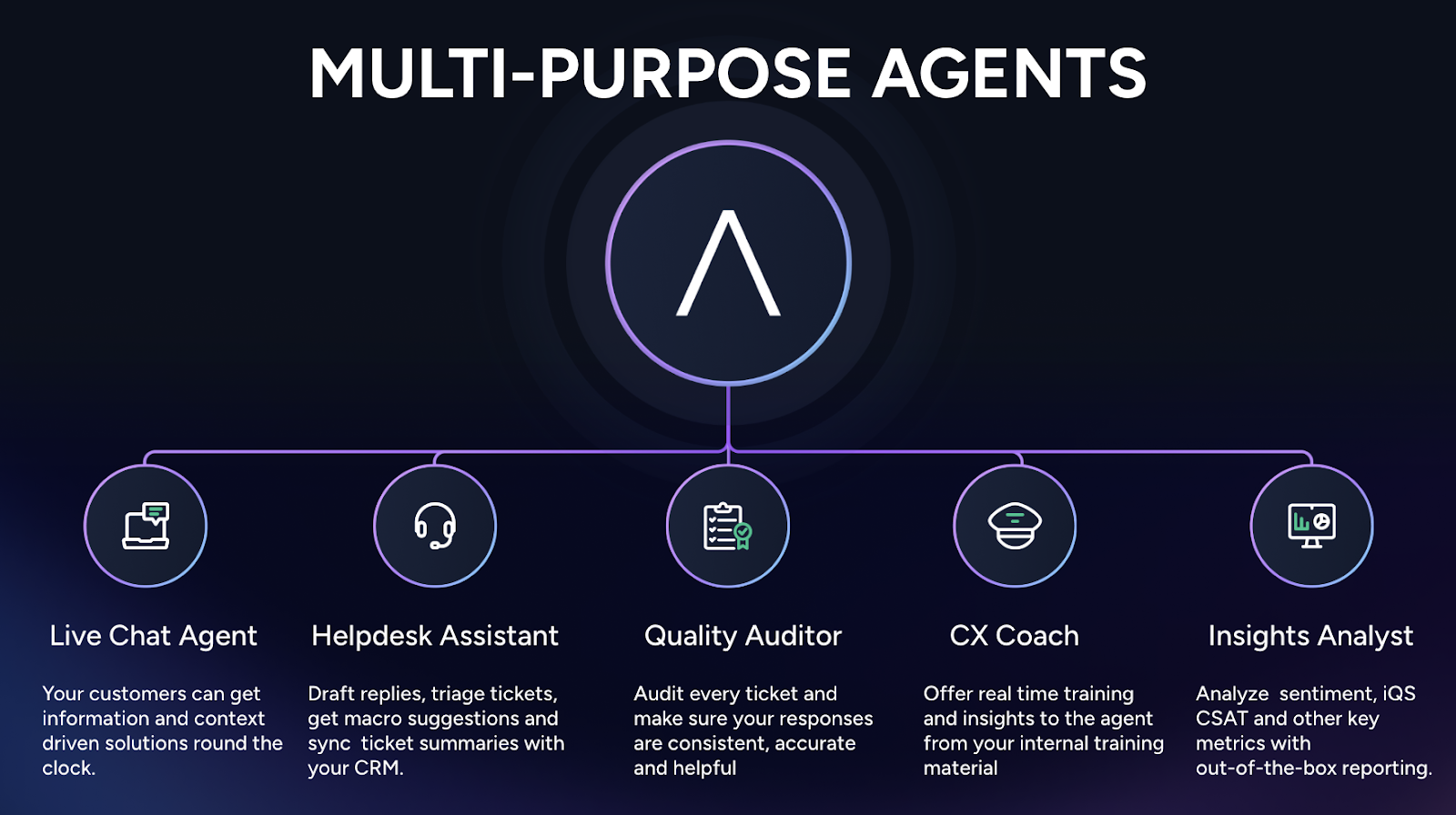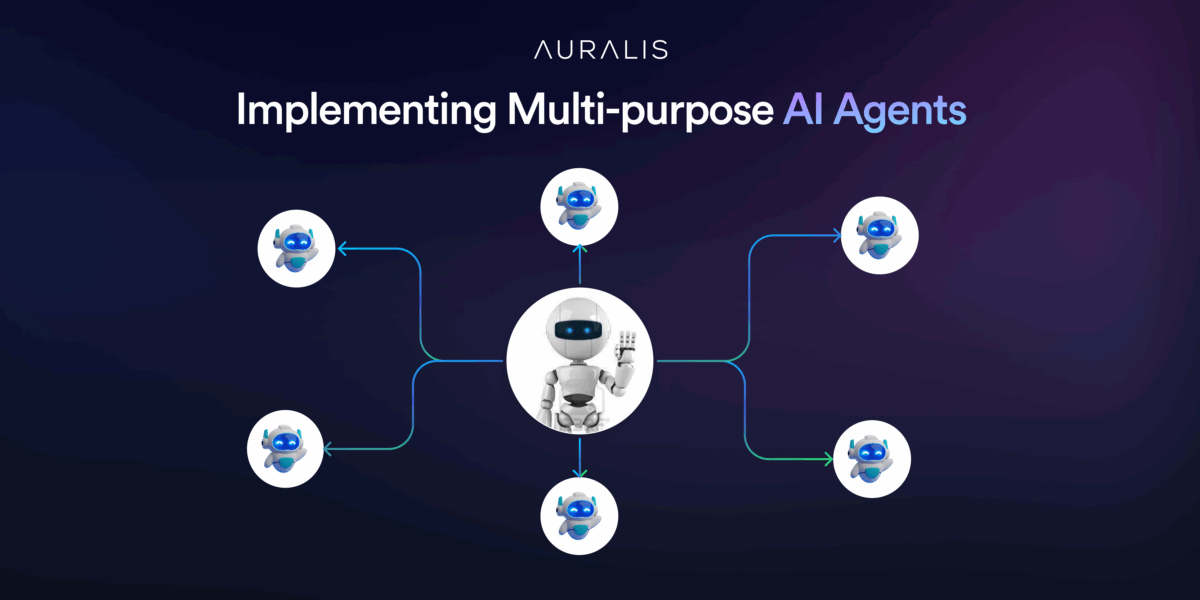Understanding How to Implement Multi-purpose AI Agents
While we have become pretty much comfortable using voice assistants like Alexa or Siri, the next-generation multi-purpose AI agents are taking customer support to the next level.
They’re capable of supporting business operations by delivering versatile and intelligent assistance across multiple domains.
Here’s how they work and how you can implement them for maximum impact.
What are multi-purpose AI agents?
Multi-purpose AI agents are a network of AI agents that can collaborate with each other to support operations and decision-making better. Here, each AI agent specializes in a particular task, coordinates with other AI agents to exchange data, and coordinates actions.
Unlike single-function bots that operate independently, focusing on a single task, multi-purpose agents share knowledge and collaborate to perform a complex task.
Single agents can be compared to siloed helpers, while multi-purpose agents can adapt and interact across multiple business operations.
As businesses become increasingly complex and improving the customer experience becomes a primary concern for brands, AI takes center stage in customer experience and support ecosystems.
And that comes as no surprise because in this hyper-connected world, customers no longer want to wait for a resolution.
They want support that’s fast and accurate. And thus, versatility becomes the new standard for AI-powered assistance, where multi-purpose AI agents just seem to fit right.
The five pillars of multi-purpose AI agents
Modern businesses need more than reactive support agents. They need smart, on-time agents that can support efficiency and speed without compromising on quality at every instance. The five pillars of multi-purpose AI agents play a crucial role in delivering exactly that.

1. Live chat agent
As the name suggests, the job of a live chat agent is to provide real-time, context-driven information and solutions to customers.
It’s available 24/7 and offers a personalized response based on previous interactions, user behavior, and system data.
It’s beneficial for troubleshooting, answering product queries, and assisting customers with completing a transaction.
Key capabilities
- 24/7 availability across channels
- Personalized, context-aware responses
- Handling a wide range of queries, including both technical and non-technical queries
Business impact
- Reduced wait times
- Improved customer satisfaction
- Consistency in support quality
2. Helpdesk assistant
A helpdesk assistant comes in handy in streamlining internal support workflows for agents. They work behind the scenes, helping the human agents improve their efficiency, minimize errors, and improve their productivity.
These assistants are good at keeping the CRM records up-to-date, drafting responses, and triaging incoming tickets.
Key capabilities
- Drafting replies and triaging tickets
- Offering macro suggestions for faster resolution
- Syncing ticket summaries with CRM systems
Business impact
- Boosting agent efficiency and productivity
- Faster ticket resolution with minimal human intervention
- Seamless integration with existing support tools
3. Quality auditor
This agent ensures quality and compliance are maintained at all times. Its main responsibility is to flag any inconsistencies in messaging, compliance, or other inaccuracies.
Key capabilities
- Acts as a real-time auditor, auditing every ticket for accuracy and helpfulness
- Identifying inconsistencies and knowledge gaps
- Providing actionable feedback for continuous improvement
Business impact
- Ensuring higher-quality interactions consistently
- Reducing error rates, thus minimizing the risk of compliance issues or reputational risks
- With stronger compliance, you can build better customer trust
4. CX coach
The CX coach offers real-time training and upskilling to support agents. It provides contextual guidance to the human agent during live calls, facilitating better understanding, retrieving helpful resources from the knowledge base, and supporting continuous learning.
Key capabilities
- Delivering insights from internal training materials on demand
- Real-time feedback and guidance during live calls
- Adaptive coaching based on agent performance metrics
Business impact
- Ensures faster onboarding for new agents
- Enables continuous skill development for the existing agents
- Ensures there is a consistent customer experience across all touchpoints
5. Insights Analyst
The role of the insight analyst is to turn support data into actionable business intelligence. It analyzes customer sentiments, performance metrics, and feedback, helping decision-makers refine their product and customer support strategies.
Key capabilities
- Analyzing sentiment, CSAT, and other key metrics is a key capability of this agent
- Providing out-of-the-box reporting with pre-built reports
- Identifying trends and areas for improvement
Business impact
- With better insight into customers’ pain points and needs, it enables more informed, data-driven decision-making
- Enhanced customer experience strategies
- Visibility into support performance and customer needs, and better cross-functional collaboration
Key benefits of deploying multi-purpose AI agents
As multi-purpose AI agents are nuanced with deep specializations as compared to the standard solutions available, they offer multiple benefits.
- Multi-purpose agents help break down silos by reducing the common obstacles of complex processes. Thus, it ensures there’s a unified user and customer experience across platforms.
- With AI agent automation, you can save costs drastically, as it eliminates obstacles caused by operational challenges and errors that typically occur in manual processes. Plus, as it promotes cross-functional collaboration, operational efficiencies are further improved.
- AI agents are adept at handling more queries without increasing headcount, empowering companies to expand in a cost-effective manner. Additionally, it enhances operational efficiencies.
- Multi-purpose AI agents thrive on data, learning and adapting over time. Every time it receives a user interaction, it learns from it and refines its subsequent responses, thereby becoming more relevant and accurate.
- The versatility of multi-purpose AI agents enables customers to receive support 24/7 with proactive recommendations, thus reducing the need to wait for a human agent for support. On the other hand, these AI agents support internal teams with contextual information, coaching, and the automation of repetitive tasks. All these factors help improve efficiency and productivity.
Implementation roadmap: How to deploy multi-purpose AI agents
With thoughtful integration and coordination, AI agents can achieve their full potential. Here’s how you can go about it.
1. Assessing business needs and identifying use cases
Start with identifying your workflows and bottlenecks where AI agents can drive maximum value. Whether automating repetitive tasks, answering customer questions, or routing tickets, identifying the use cases is the first step to ensure you’re using AI agents where they’re needed most.
2. Choosing the right AI platform or vendor
Choosing the right vendor is equally important as it will ultimately impact your purpose of implementing AI agents.
Some of your key considerations should be
- What purpose do you want to solve with the AI agents? Is it data analysis, automation, or improving the overall customer experience?
- See if there’s sync with the platform’s capabilities and your needs.
- Look into the vendor’s customer support facility. Do they offer hands-on training to use the tool better?
3. Integrating with existing systems
As AI agents need to interact seamlessly with your current tech stack, choose a solution that allows easy integration with your existing CRM, ticketing system, and knowledge base. For example, Auralis AI enables easy integration with the most popular enterprise tools.
4. Training AI agents with company-specific data and scenarios
The performance of AI agents largely depends on how they are trained to handle specific business scenarios. Training them on context-rich company-specific data and scenarios helps build a solid foundation to ground their decisions and actions.
5. Setting up feedback loops for continuous improvement
A feedback loop allows your AI agent to learn from every interaction and user behavior. This can improve the overall customer experience significantly over time. To make it work, establish a feedback loop and make it easy for users to share their feedback. For example, a simple “thumbs up or thumbs down” can gather the user’s sentiment.
6. Monitoring performance and iterating based on analytics
Just implementing multi-purpose AI agents is not enough. You need to continuously measure, analyze, and optimize the performance of your agents. Identify the weak intents or the misunderstood prompts from the interaction log.
Integrate A/B testing and the AI behavior based on new prompt styles. Doing this repeatedly helps you understand what’s working and where your AI agents are making mistakes.
Best practices for success
For the optimal performance of the multi-purpose AI agents, follow these tips.
1. Start with clear objectives and KPIs
Know your objectives before implementing the multi-purpose AI agents. Is your primary goal to improve customer satisfaction, reduce ticket volume, or support the internal teams? Once you have identified the goals, determine your measurable KPIs for each one.
2. Ensure seamless handoff between AI and human agents
AI agents are designed to support human agents, not replace them. Hence, you must design your workflow in a way that allows smooth transitions from AI to human agents when necessary, with complete context handover.
This helps in minimizing friction while ensuring faster resolution, especially when the issue is complex and needs to be dealt with empathy.
3. Invest in data quality and regular training updates
Performance of AI largely depends on the quality of the data it’s trained on. So, invest in data quality, ensuring it’s up to date, accurate, and involves real-world business scenarios. This will help your AI agents perform better and produce accurate results.
4. Foster a culture of feedback and learning
Encourage customers and partners to share feedback on their AI usage. Use this feedback to train your AI in refining its tone, behavior, and accuracy of results.
5. Prioritize security, privacy, and compliance
Data privacy and compliance are a serious concern, particularly within the context of AI-powered customer support. Ensure you adhere to all industry-set guidelines to build trust among your users. For example, Auralis AI ensures that all sensitive data and PII is pre-processed.
Common challenges and how to overcome them
While multi-purpose AI agents have significant benefits on business operations, there are a few hurdles that you need to overcome.
1. Resistance to change among staff
Introducing AI in your existing workflow can cause resistance among the staff members. This may arise from the fear of losing a job, adding more complexities to the workflow, or a lack of control.
However, you can overcome such apprehension easily.
Clearly communicate that AI is here to enhance operational efficiency and improve agent productivity, not to replace their jobs. Offer intensive training on how to use the AI agents within the existing workflow. Remember, effective change management and communication are the best ways to build trust and encourage early adoption.
2. Data silos and integration hurdles
To perform optimally, AI needs to access all available data within your company, including product documents, internal knowledge bases, and past interactions. Fragmented data can hinder the performance of the AI agent.
However, by choosing a friendly AI tool, you can easily overcome such a challenge. For example, Auralis AI enables integrations with the most popular CRMs, ticketing tools, and enterprise databases.
3. Balancing automation with the human touch
While automation helps in scaling up with faster resolution, too much automation can make it feel impersonal. To strike the right balance, design AI workflows that include human intervention for complex or sensitive issues.
Ensure smooth handoffs with full context so users feel heard and supported. Personalizing automated interactions using past data and tone adjustments can also help maintain empathy and trust.
4. Ensuring transparency and explainability in AI decisions
To build trust and drive adoption, it’s important that users understand how AI agents make decisions. Implement explainable AI models that can justify outcomes in simple terms. This ensures accountability and helps users feel more confident interacting with AI-powered systems.
Conclusion
Multi-purpose AI agents are changing how businesses offer support and gain insights. They handle tasks, improve customer service, and help teams work better. When trained well and used with clear goals, they boost speed, accuracy, and results.
Ready to see it in action? Book a demo of Auralis AI today.
